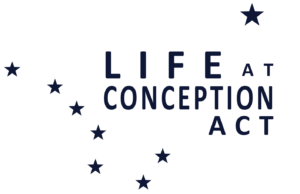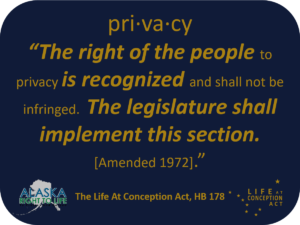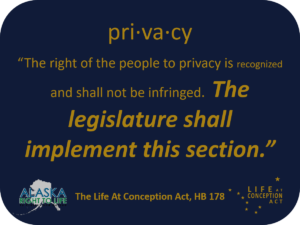LIFE AT CONCEPTION
pri·va·cy
According to the Citizen’s Guide to the Constitution, Article 1, Section 22 was added to the Alaska Constitution because Alaskans were concerned about “the potential for technological intrusion into the lives of ordinary citizens.”
When we consider how we got to the point where abortion proponents consider Alaska to be an “Abortion Safe State,” the issue of our constitutional right to privacy can be found right at the center of the issue in Alaska.
Let’s go back to our Constitution’s treatment of privacy: “The right of the people to privacy is recognized and shall not be infringed. The legislature shall implement this section.”
We see a right: privacy.
We see protection: shall not be infringed.
We see the responsible body: the legislature.
We see authority: shall implement.
Yes, spelling it out like this is necessary. Just ask your elected representatives who is responsible and has the authority to implement Article 1, Section 22. You’ll likely want to use the text above to spell it out for them.
So we see that the body of government given both the responsibility and authority to act on the issue of privacy is the legislature.
The legislature. Not the executive branch. Not the judiciary. But the legislature.
But in 1997, the judiciary took powers reserved for the legislature and defined the right to privacy to include abortion in Valley Hospital Association v. Mat-Su Coalition for Choice.
Chief Justice Compton writes in his opinion, “We hold that (1) Article I, section 22 of the Alaska Constitution encompasses reproductive rights, including abortion.”
And ever since 1997, abortion has been protected within the State of Alaska under the constitutional right to privacy as indicated in Article 1, Section 22.
Or is it?
The statement, “We hold that (1) Article I, section 22 of the Alaska Constitution encompasses reproductive rights, including abortion,” is valid only if it were written by members of the Alaska Legislature.
Remember, the constitution says, “the legislature shall implement this section.”
Since 1997, Alaska’s courts have taken the legislature’s enumerated powers as their own in a cascade of pro-abortion decisions and opinions that have made the State of Alaska the single largest supporter, donor, and payment source for Alaska’s abortion industry.
- 2001 State v. Planned Parenthood – citing “the exercise of a constitutional right, the right to reproductive freedom as declared in 1997 above.
- 2001 State v. Planned Parenthood – upholding the 1997 privacy decision, Remand for Hearing.
- 2007 State v. Planned Parenthood – striking down parental consent requirements.
- 2010 Planned Parenthood v. Campbell – the judicial rewriting of Parental Notification Ballot Initiative.
- 2013 Desjarlais v. State – Denial of Personhood Ballot Initiative.
- 2016 Planned Parenthood v. State – Striking down Parental Notification Law.
- 2019 State v. Planned Parenthood – Striking down Medically Necessary Abortions Under Medicaid.
As long as Alaska’s courts are allowed to claim the legislature’s powers as their own, Alaska will continue to be one of the most abortion-friendly states in the country.
The LIFE At Conception Act
The end of abortion in Alaska
The LIFE At Conception Act is a comprehensive bill that eliminates legalized child killing in Alaska from the moment of conception without exception to the child’s age, level of development, disability, sex, nature of conception, or any other distinguishing characteristic.
The LIFE At Conception Act protects all innocent human life from the moment of conception to natural death by addressing several points in Alaska’s Constitutional and Statutory Laws:
- Eliminates abortion access from the right to privacy, according to the parameters of Article 1, Section 22 of the Alaska State Constitution.
- Defines children in the womb from the moment of conception as ‘natural persons.’
- Defines conception as the beginning of the biological development of a human organism, when the sperm and egg fuse.
- Defines abortion as the action taken before or during the birth of a child with the intent to kill the child.
- Repeals Alaska’s abortion laws and statutes, primarily Alaska Statute 18.16.
- Creates criminal penalties for any intentional killing of a child at any age equivalent to negligent homicide, murder, or any other intentional killing of a person.






